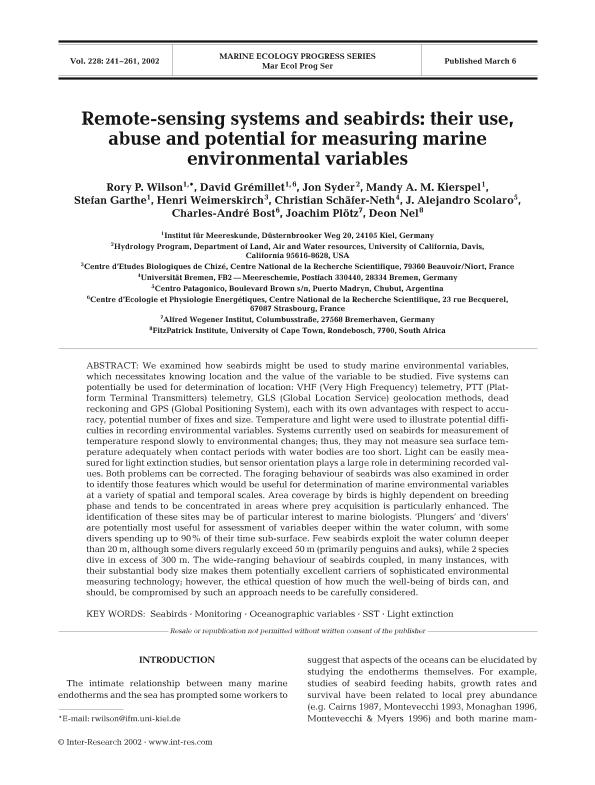Artículo
Remote-sensing systems and seabirds: their use, abuse and potential for measuring marine environmental
Wilson, Rory P; Grémillet, David; Syder, Jon; Kierspert, Mandy; Garthe, Stefan; Weimerskirch, Henri; Schafer Neth, Christian; Scolaro, Jose Alejandro ; André Bost, Charles; Plotz, Joachim; Nel, Deon
; André Bost, Charles; Plotz, Joachim; Nel, Deon
 ; André Bost, Charles; Plotz, Joachim; Nel, Deon
; André Bost, Charles; Plotz, Joachim; Nel, Deon
Fecha de publicación:
03/2002
Editorial:
InterResearch Science Center
Revista:
Marine Ecology Progress Series
ISSN:
0171-8630
Idioma:
Inglés
Tipo de recurso:
Artículo publicado
Clasificación temática:
Resumen
We examined how seabirds might be used to study marine environmental variables, which necessitates knowing location and the value of the variable to be studied. Five systems can potentially be used for determination of location: VHF (Very High Frequency) telemetry, PTT (Platform Terminal Transmitters) telemetry, GLS (Global Location Service) geolocation methods, dead reckoning and GPS (Global Positioning System), each with its own advantages with respect to accuracy, potential number of fixes and size. Temperature and light were used to illustrate potential difficulties in recording environmental variables. Systems currently used on seabirds for measurement of temperature respond slowly to environmental changes; thus, they may not measure sea surface temperature adequately when contact periods with water bodies are too short. Light can be easily measured for light extinction studies, but sensor orientation plays a large role in determining recorded values. Both problems can be corrected. The foraging behaviour of seabirds was also examined in order to identify those features which would be useful for determination of marine environmental variables at a variety of spatial and temporal scales. Area coverage by birds is highly dependent on breeding phase and tends to be concentrated in areas where the prey acquisition is particularly enhanced. The identification of these sites may be of particular interest to marine biologists. ?Plungers?and ?divers? are potentially most useful for assessment of variables deeper within the water column, with some divers spending up to 90% of their time sub-surface. Few seabirds exploit the water column deeper than 20 m, although some divers regularly exceed 50 m (primarily penguins and auks), while 2 species dive in excess of 300 m. The wide-ranging behaviour of seabird coupled, in many instances, with their substantial body size makes them potentially excellent carriers of sophisticated environmental measuring technology; however, the ethical question of how much the well-being of birds can, and should, be compromised by such an approach needs to be carefully considered.
Palabras clave:
SEABIRDS
,
MONITORING
,
OCEANOGRAPHIC ECOLOGY
,
MIGRATION
Archivos asociados
Licencia
Identificadores
Colecciones
Articulos(CCT-CENPAT)
Articulos de CTRO.CIENTIFICO TECNOL.CONICET - CENPAT
Articulos de CTRO.CIENTIFICO TECNOL.CONICET - CENPAT
Citación
Wilson, Rory P; Grémillet, David; Syder, Jon; Kierspert, Mandy; Garthe, Stefan; et al.; Remote-sensing systems and seabirds: their use, abuse and potential for measuring marine environmental; InterResearch Science Center; Marine Ecology Progress Series; 228; 3-2002; 241-261
Compartir
Altmétricas



